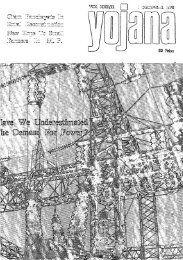Banking - Yojana
Banking - Yojana
Banking - Yojana
- TAGS
- banking
- yojana
- yojana.gov.in
Create successful ePaper yourself
Turn your PDF publications into a flip-book with our unique Google optimized e-Paper software.
Generated by PDFKit.NET Evaluation<br />
introduction of Internet<br />
connectivity in the country in 1989.<br />
As such, E-commerce in India is of<br />
recent origin and is still at infant<br />
stage. Historically, Rediff-on-thenet,<br />
one of India's leading online<br />
services, set up India's first Ecommerce<br />
on August 13, 1998.<br />
Then, India entered the age of Ecommerce<br />
the day the government<br />
deregulated the In ternet service<br />
provider (ISP) policy in November<br />
1998. Since then, there is no<br />
, • looking back and the coun try is<br />
proliferating in Internet. In fact, the<br />
rate of growth of penetration of<br />
, Internet has been spectacular. It<br />
took radio 50 years to have 50<br />
million owners, T.v. 16 years and<br />
personal computers 1'7years. But it<br />
has taken Internet only 4 years to<br />
reach that figure after the inven tion<br />
ofWWW an browsers. As of May 31,<br />
2002, there were 0.95 million<br />
Internet connections in the country<br />
with 3.25 million Internet users.<br />
According to NASSCOM, these<br />
figures will reach to 6 and 16 million<br />
respectively by March 31, 2003.<br />
Nonetheless, Internet penetration<br />
in India (0.5 percent of population)<br />
is far less as compared to 50 percent<br />
in Singapore, for example.<br />
As per preliminary findings of<br />
the NASSCOM survey, the total<br />
volume ofE-commerce transactions<br />
in India was about Rs. 4,500 million<br />
) in the year 1999-2000. Out of this<br />
volume, aboutRs. 500 million were<br />
• contributed by retail Internet or<br />
'\ "'business-to customer transactions,<br />
and about Rs. 4,000 million was<br />
contributed by business-to-business<br />
transactions. According to<br />
NASSCOM survey; with<br />
improvemen t in telecom<br />
infrastructure, increase in P.C.<br />
penetration could lead to Rs. 15,000<br />
million ofE-commerce transactions<br />
in India by 2001-2002. Recently, the<br />
government has opened the gates<br />
further for foreign companies by<br />
YOJANAJuly 2002<br />
Click here to unlock PDFKit.NET<br />
allowing 100% foreign direct<br />
investment (FDI) in E-commerce<br />
and removing the export obligation<br />
for consumer goods industries<br />
covering a basket of 22 products<br />
such as cars, refrigerators, washing<br />
machines, colourTVs, wines, liquor<br />
and food products. Thus, Ecommerce<br />
is showing every sign of<br />
continuing to expand in the<br />
country.<br />
Uneve'n<br />
It is worth mentioning that the<br />
expansion of E-commerce in India<br />
so far has been uneven<br />
concentrating in a few metropolitan<br />
cities, namely, Bangalore,<br />
Hyderabad, Mumbai and Delhi.<br />
The common man residing in rural<br />
and remote areas of the country is,<br />
however, still unaware of happening<br />
in information technology sector<br />
and thus, E-commerce<br />
phenomenon. Obviously, much<br />
progress cannot be achieved until<br />
the country's vast rural and remote<br />
sector is not brought within the<br />
folds of Internet. Hence, hitherto<br />
untouched rural sector by Internet<br />
so far offers a greatpotential for Ecommerce<br />
in India. The former<br />
U.S. President Mr Bill Clinton<br />
during his visit to India in March<br />
2000 also hailed India's remarkable<br />
progress in IT sector and remarked<br />
that India has the poten tial to<br />
become the world's largest<br />
economy using the power of<br />
Internet to tap its vast potential<br />
lying dormant in its rural and<br />
remote areas.<br />
Entrepreneurship development<br />
usually goes with development of<br />
small-scale enterprises. Like<br />
elsewhere in the world, small<br />
enterprises playa vibrant and vital<br />
role in our coun try as well by<br />
contributing significantly to the<br />
national production, employment,<br />
and exports. This is more so in case<br />
of rural and remote areas like North<br />
Eastern Region ofIndia. Given the<br />
kingpin role of small enterprises<br />
worldwide, it is increasingly being<br />
realized that if small sector gets left<br />
behind in the information, then the<br />
whole economy gets behind.<br />
Marketing being one of the major<br />
problems faced by small<br />
enterprises, these enterprises<br />
cannot have the luxury to adopt a<br />
wait and watch attitude in the<br />
matter of marketing. Late adoptio~<br />
ofE-commerce will adversely affect<br />
the small enterprises today and<br />
tomorrow.<br />
It is with this realization; small<br />
enterprises worldwide are turning<br />
to the use of modern (marketing)<br />
technology to compete with their<br />
big brothers-medium and large size<br />
enterprises. According to a survey<br />
conducted by the Yankallovick<br />
Partners Inc., 90 percent small<br />
enterprises in US, 81 percent in<br />
Singapore, 80 percent in Spain and<br />
Italy, and 70 percent in Ireland are<br />
using wired technology in their<br />
(marketing) operations.<br />
The information technology in<br />
the form of E-commerce has<br />
opened up a great deal of potential<br />
for developing small enterprises in<br />
the field of marketing. The unique<br />
opportunities E-commerce offers to<br />
small enterprise are to:<br />
Access to new Markets: Ecommerce<br />
enables the marketer to<br />
have access to markets anywhere in<br />
the globe hitherto untapped .<br />
Lower Various Costs: Ecommerce<br />
can minimize inventory<br />
costs by adoptingjust-in-time (JIT)<br />
system and enhancing the firm's<br />
ability to forecast demands more<br />
accurately. It has been found that<br />
both customer and after sale<br />
services account for upto onetenth<br />
(10 percent) of operating<br />
costs. But, by putting these services<br />
on-line under E-commerce, these<br />
costs get reduced, and<br />
29






